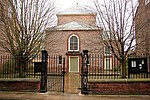St John's in the Marsh Church, York
Former churches in North YorkshireRoman Catholic churches in YorkUnited Kingdom Roman Catholic church stubsUse British English from April 2017Yorkshire building and structure stubs
St John's in the Marsh (also known as St John the Baptist) was a church in York, United Kingdom. It was located near the River Foss and Hungate, adjacent to the Hungate dig.The church was built sometime before 1154 and demolished by 1550, about the time of the Reformation but not closed because of it.
Excerpt from the Wikipedia article St John's in the Marsh Church, York (License: CC BY-SA 3.0, Authors).St John's in the Marsh Church, York
Hungate, York Layerthorpe
Geographical coordinates (GPS) Address Nearby Places Show on map
Geographical coordinates (GPS)
| Latitude | Longitude |
|---|---|
| N 53.959055555556 ° | E -1.0765555555556 ° |
Address
Hungate
Hungate
YO1 7NP York, Layerthorpe
England, United Kingdom
Open on Google Maps









